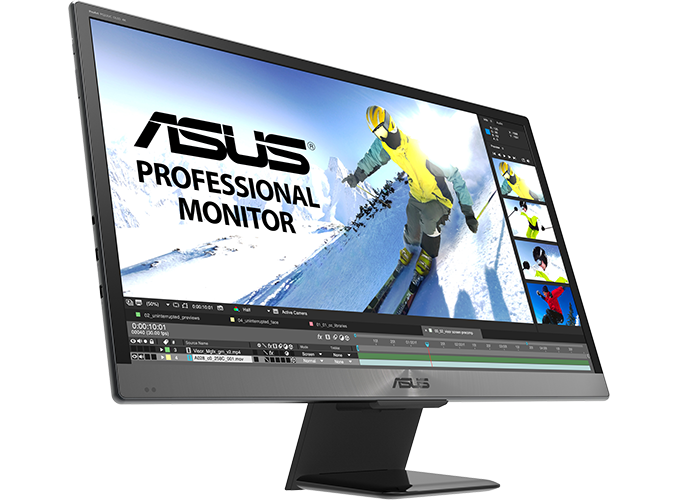ASUS Unveils ProArt PQ22UC OLED Monitor: 4K, 99% DCI-P3, 0.1 ms Response Time
by Anton Shilov on January 10, 2018 3:00 PM EST- Posted in
- CES 2018
- Displays
- Asus
- Trade Shows
- 4K
- Monitors
- OLED
- HDR
- ProArt
- ProArt PQ22UC

LAS VEGAS, NV — ASUS has announced its first professional OLED display at CES 2018. The ProArt PQ22UC features a 4K resolution and covers 99% of the DCI-P3 color space, making it a good solution for professionals who need this spectrum. ASUS says that the compact dimensions and light weight of the device make it a good option both for post-production and on-set routines.
The ASUS ProArt PQ22UC is based on a 21.6” 4K RGB stripe OLED panel made by JOLED (a joint venture between Sony and Panasonic) using the company’s printing method. The panel features a 3840×2160 resolution, a contrast ratio of 1,000,000:1, and a response time of 0.1 ms. The monitor can reproduce 1.07 billion colors and covers 99% of the DCI-P3 color space. ASUS does not say anything about the brightness of the panel, 3D LUT, sRGB, and Rec. 2020 support. The company does say that the “dynamic range is wide enough to support HDR content”, so the look-up tables are there, but it is unknown whether the PQ22UC supports the HDR10 or other high dynamic range specs. In any case, HDR requires relatively high brightness levels and luminance is not a strong side of the OLED technology in general, so the actual HDR experience on the PQ22UC is something that remains to be seen. Meanwhile, 3D LUTs can be used on set to emulate specific display devices for quality assessments.
ASUS positions the ProArt PQ22UC as a professional solution for those on the go, which is why it uses USB Type-C and micro-HDMI inputs (no word on exact protocols, but DP 1.2 and HDMI 2.0x are likely) to save space. The display features an angled stand that can regulate height & tilt and can be detached and folded flat for easier transportation.
| Brief Specifications of the ASUS ProArt PQ22UC | |
| PQ22UC | |
| Panel | 21.6" OLED |
| Native Resolution | 3840 × 2160 |
| Maximum Refresh Rate | 60 Hz (?) |
| Response Time | 0.1 ms (black to white) |
| Brightness | typical: unknown minimum: 0.0005 cd/m² (minimum) |
| Contrast | 1000000:1 |
| Viewing Angles | 178°/178° horizontal/vertical |
| Pixel Pitch | 0.1245 mm² |
| Pixel Density | 204 ppi |
| Display Colors | 1.07 billion |
| Color Gamut Support | DCI-P3: 99% sRGB/Rec 709: 100% (tbc) Adobe RGB: ? SMPTE C: ? Rec2020: ? |
| Stand | Tilt and height adjustable |
| Inputs | 1 × USB Type-C (DP 1.2?) 1 × mini HDMI (2.0a? 2.0b?) |
| PSU | External |
| Launch Price & Date | unknown |
The display is factory calibrated to Delta E≦2 color accuracy and comes with the ASUS ProArt Calibration feature that saves color parameter profiles to the monitor rather than to a host PC, which is particularly useful for a mobile solution that can be attached to different computers.
ASUS has not released any details regarding pricing and availability timeframes of the ProArt PQ22UC. Meanwhile, JOLED says that its 21.6” 4K OLED panels are in production.
Related Reading:
Source: ASUS











25 Comments
View All Comments
TheWereCat - Wednesday, January 10, 2018 - link
Too bad it's only 21.6" ... 32"-34" would be awesome but I guess that would drive the price into the sky.vortmax2 - Wednesday, January 10, 2018 - link
...to the moonTheWereCat - Wednesday, January 10, 2018 - link
Well.... yeah.Alistair - Wednesday, January 10, 2018 - link
I'd be fine with a 25". Sad about the size for sure.Freakie - Wednesday, January 10, 2018 - link
Most on-site production monitors are this small. They aren't meant for doing your entire post-production on. They are meant to be something that you can look at the images/video coming off the camera and any other in-line automatic processing devices you have setup so that you can make immediate corrections to the live feed. And if you ARE using this post-production, you're of course putting just the video on this screen with your work-space on other screens.For the industry they are aiming this at, the size is just fine.
mkozakewich - Wednesday, January 10, 2018 - link
It's only 204ppi. On my desktop monitor (roughly 100ppi), I can see every little fuzzy square around this text, and I'm just done with it. 200 at least isn't that bad from three feet away, but I can still see aliasing and such.JoeyJoJo123 - Thursday, January 11, 2018 - link
I have a 4k 24" at home, I see 0 aliasing at all from normal desk position. Disabled AA looks perfect for games playing at native 4k resolution, but the framerate may suffer if you choose to enable lots of other options.4K at 21.5" is just fine with me.
zepi - Saturday, January 13, 2018 - link
This looks like a nice extensiom screen for high-dpi laptops. It would be usable with same scaling factor as the main screen of the laptop and things would not be hugely different in size.Like 3K/15” and 2560/13” laptops.
I agree, 24” 4K monitor is lovely to use. I wouldn’t take bigger one with 4K as I prefer to have considerably higher dpi than the age old windows standard of 96ppi. And to get good scalings, it is better to go nearer to 200 instead of jumping to 140 or somehing like that.
Gc - Friday, January 12, 2018 - link
It's a portable monitor, so the size is limited to airline carry-on size restrictions. If you travel with the screen in checked baggage it will need a much heavier protective case.Magichands8 - Wednesday, January 10, 2018 - link
And the point of having a display with a .1ms response time running at 60hz would be...? ASUS like Acer is known for it's very poor quality control and support so let's see if they can release this without massive screen quality issues and without severe burn-in, life time and frame rate issues. When they offer something like this without those issues at at least 144hz and 27" then it will be interesting. This may be expensive but as detailed it's worthless to me.